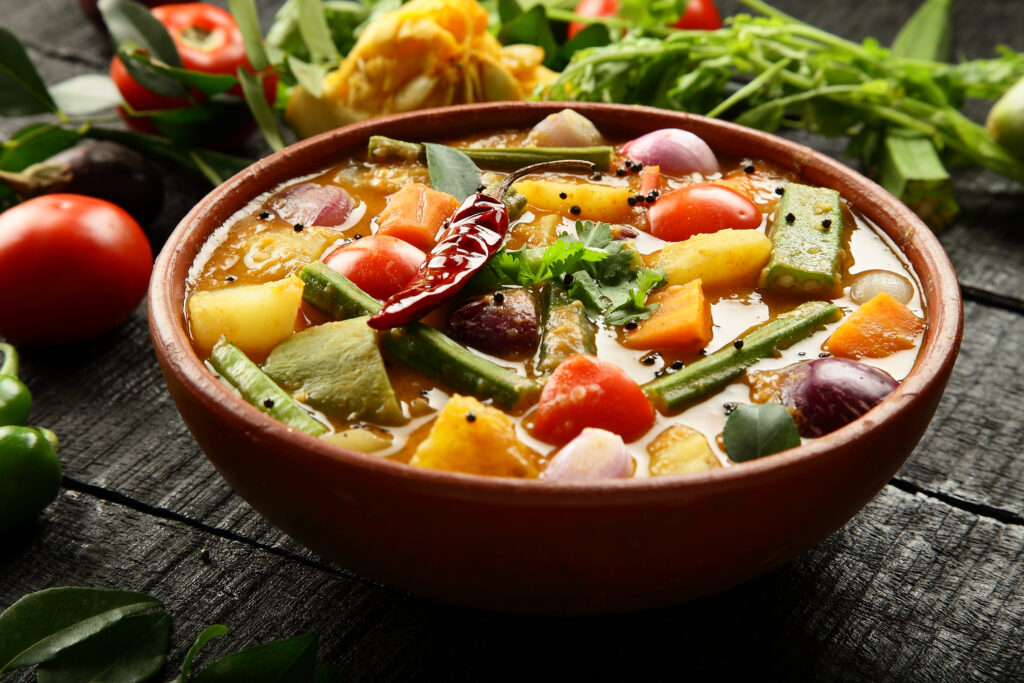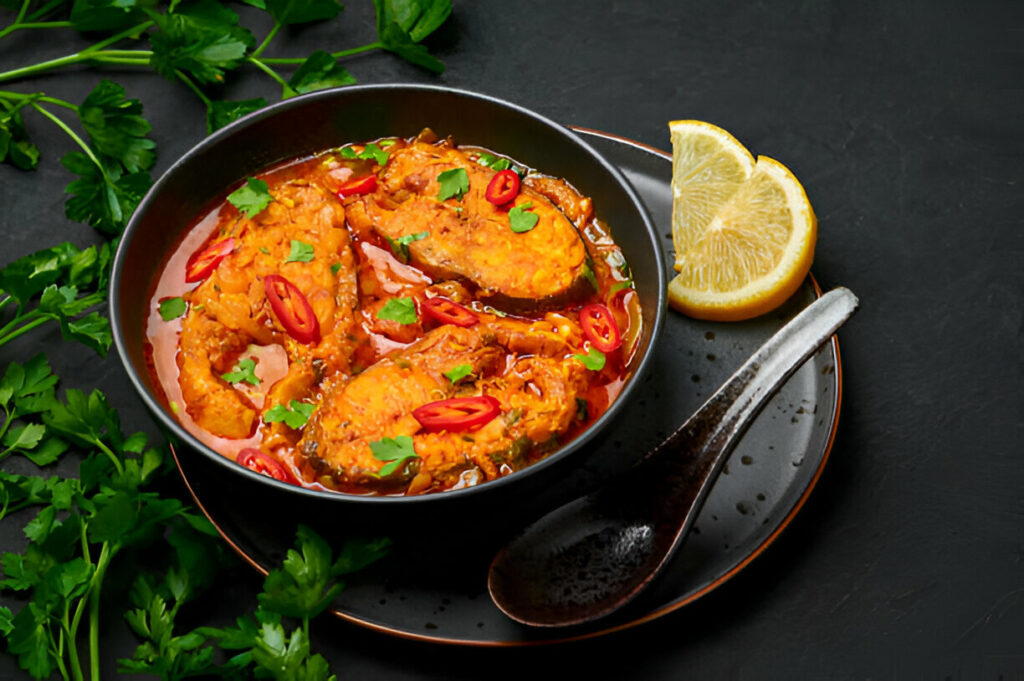East Indian
Indian Cuisines
Shukto
Shukto is a traditional Bengali dish that holds a unique place in Bengali cuisine, known for its subtle bitterness and delicate flavors.
Dalma
Dalma is a traditional dish from the eastern Indian state of Odisha, known for its simplicity, nutritious value, and delicious flavor.
Litti Chokha
A traditional dish from Bihar consisting of roasted wheat flour dumplings (litti) stuffed with sattu (roasted gram flour), served with chokha (mashed vegetables like eggplant, tomato, and potato).
Macher Jhol
Macher Jhol, also known simply as “fish curry,” is a staple Bengali dish renowned for its simplicity and delightful flavors.
Aloo Pithika
A simple yet delicious Assamese dish made with mashed potatoes seasoned with mustard oil, onions, green chilies, and sometimes garnished with coriander leaves.

Shukto
Shukto is a beloved Bengali dish characterized by its delicate balance of flavors and textures. It features a medley of bitter and mild vegetables such as bitter gourd, raw banana, drumsticks, and more, simmered in a sauce made from milk, coconut, and spices. The dish often incorporates mustard paste for a subtle kick. Shukto is cherished for its creamy consistency, combining bitter, sweet, and slightly spicy notes harmoniously. It’s traditionally served at the beginning of a meal to prepare the palate in Bengali cuisine, showcasing the region’s penchant for nuanced tastes and culinary finesse.
- Ingredients
- Method
- Vegetables:
- 1 medium-sized bitter gourd (karela), thinly sliced
- 1 medium-sized raw banana (kachcha kela), peeled and sliced
- 1 medium-sized potato, peeled and sliced
- 1 cup of drumsticks, cut into 2-3 inch pieces (optional)
- 1 cup of raw papaya, peeled and sliced (optional)
- Other Ingredients:
- 1 tablespoon mustard paste (made by grinding mustard seeds with water)
- 1 tablespoon poppy seed paste (ground poppy seeds)
- 1 tablespoon ginger paste
- 1 tablespoon clarified butter (ghee) or mustard oil
- 1/2 teaspoon turmeric powder
- Salt to taste
- 1 teaspoon sugar (optional)
- 2-3 green chilies, slit
- 1 cup milk (or more as needed)
- A handful of posto (poppy seeds) for garnish (optional)
- Preparation of Vegetables:
- Prepare all vegetables by washing, peeling, and slicing them as mentioned in the ingredients list.
Blanching Bitter Gourd:
- Place the sliced bitter gourd in a bowl and sprinkle with salt. Rub the salt into the bitter gourd slices and let it sit for about 10-15 minutes. Then, rinse off the salt thoroughly and drain.
Cooking Process:
- Heat the ghee or mustard oil in a deep pan or kadhai over medium heat.
- Add the blanched bitter gourd, raw banana, potato, drumsticks, and papaya (if using). Sauté them for a few minutes until they are slightly tender.
Adding Spices:
- Add the ginger paste, mustard paste, poppy seed paste, turmeric powder, and salt to taste. Mix well to coat the vegetables evenly with the spices.
Simmering:
- Pour in the milk gradually while stirring continuously. Adjust the amount of milk to achieve the desired consistency (usually a thin gravy). Add slit green chilies.
Seasoning:
- If using sugar, add it at this stage to balance the flavors. Taste and adjust salt if needed.
Cooking:
- Cover the pan and let the vegetables cook on low to medium heat until they are completely tender and the flavors have melded together. Stir occasionally to prevent sticking.
Finishing Touch:
- Once cooked, remove from heat and let it rest for a few minutes before serving. Optionally, sprinkle some posto (poppy seeds) on top for garnish.
Serving:
- Shukto is typically served hot with steamed rice as part of a traditional Bengali meal.
This recipe yields a mild yet flavorful dish that showcases the subtle bitterness of the vegetables balanced by the creamy texture from the milk and richness from the ghee or mustard oil. Adjust the spices and milk quantity according to your taste preferences. Enjoy your Shukto!

Dalma
Dalma is a traditional dish from Odisha, India, known for its simplicity and nutritious value. It’s a wholesome preparation of lentils (usually tur dal) cooked with assorted vegetables like raw bananas, pumpkin, and beans. Seasoned with ginger, cumin, and sometimes mustard seeds, Dalma is simmered to a creamy consistency and finished with a tempering of ghee or oil, dried red chilies, and curry leaves. Its mild, comforting flavors and hearty texture make it a staple in Odia cuisine, often enjoyed with steamed rice as a complete, balanced meal rich in proteins and essential nutrients.
- Ingredients
- Method
- Toor dal (Split pigeon peas): 1/2 cup, washed and soaked for 30 minutes
- Vegetables:
- 1 medium-sized potato, peeled and diced
- 1 small raw banana (kachcha kela), peeled and diced
- 1 small sweet potato, peeled and diced
- 1 cup pumpkin or squash, peeled and diced
- 1 small eggplant, diced
- 1/2 cup chopped spinach or other greens (optional)
- Tempering:
- 2 tablespoons ghee or oil
- 1 teaspoon cumin seeds
- 1 dried red chili
- 1/2 teaspoon mustard seeds
- A pinch of asafoetida (hing)
- Spices:
- 1 teaspoon turmeric powder
- 1 teaspoon cumin powder
- 1 teaspoon coriander powder
- Salt to taste
- Others:
- 2-3 cups water (adjust as needed)
- Fresh grated coconut for garnish (optional)
Cooking Dal:
- Drain the soaked toor dal and place it in a pressure cooker or a pot with 2 cups of water. Add turmeric powder and cook until the dal is soft and mushy. If using a pressure cooker, cook for about 3-4 whistles on medium heat.
Preparing Vegetables:
- While the dal is cooking, prepare the vegetables by washing, peeling, and chopping them as mentioned in the ingredients list.
Combining Dal and Vegetables:
- Once the dal is cooked, add all the chopped vegetables (potato, raw banana, sweet potato, pumpkin/squash, eggplant) to the dal. Add cumin powder, coriander powder, and salt to taste. Mix well.
Simmering:
- Add about 1 cup of water or as needed to ensure the vegetables are submerged. Cover and simmer on low heat until the vegetables are tender, stirring occasionally. This will take about 15-20 minutes.
Tempering:
- In a separate small pan, heat ghee or oil over medium heat. Add cumin seeds, mustard seeds, dried red chili, and a pinch of asafoetida (hing). Let the seeds splutter and the chili turn slightly dark.
Final Assembly:
- Pour the tempering over the cooked dal and vegetables mixture. Stir gently to combine.
Garnish and Serve:
- Optionally, garnish with fresh grated coconut on top before serving.
Serve Hot:
- Dalma is traditionally served hot with steamed rice. It can also be enjoyed with roti or as a side dish in a thali meal.

Litti Chokha
Litti Chokha is a traditional dish from Bihar, India, consisting of roasted wheat flour dumplings filled with spiced sattu (roasted gram flour) and served with chokha, a mashed vegetable dish. Litti, the dumplings, are made by stuffing sattu mixed with spices like ajwain, turmeric, and mustard oil into wheat dough balls, which are then roasted over coal or wood fire until crisp. Chokha is typically made from mashed roasted eggplant, tomatoes, and potatoes seasoned with mustard oil, green chilies, and coriander leaves. This rustic dish is enjoyed for its hearty flavors and is often accompanied by ghee or yogurt.
- Ingredients
- Method
For Litti:
- 2 cups whole wheat flour (atta)
- 1 cup sattu (roasted gram flour)
- 2-3 tablespoons mustard oil
- 1 teaspoon carom seeds (ajwain)
- 1 teaspoon salt
- Water, as needed
For Chokha:
- 2 large potatoes, boiled, peeled, and mashed
- 2 medium-sized tomatoes, roasted and mashed
- 2-3 green chilies, finely chopped
- 1 medium-sized onion, finely chopped
- 2-3 cloves of garlic, minced
- 1 inch piece of ginger, finely chopped
- 1 tablespoon mustard oil
- 1 teaspoon mustard seeds
- 1 teaspoon cumin seeds
- Salt, to taste
- Fresh coriander leaves, chopped
For Litti:
Prepare the Dough:
- In a mixing bowl, combine whole wheat flour, carom seeds, salt, and mustard oil.
- Gradually add water and knead into a stiff dough. Cover and let it rest for 15-20 minutes.
Prepare the Filling:
- In another bowl, mix sattu with salt, mustard oil, and a little water to form a crumbly mixture.
Make the Litti:
- Divide the dough into equal-sized balls.
- Flatten each ball and place a spoonful of the sattu filling in the center.
- Carefully seal and shape into a round ball again, ensuring the filling is completely enclosed.
- Repeat for all dough balls.
Cooking Litti:
- Preheat your oven to 180°C (350°F) or heat a charcoal grill.
- Place the stuffed littis on a baking tray or skewers (if grilling).
- Bake or grill until they are golden brown and cooked through, turning occasionally for even cooking.
For Chokha:
Prepare the Roasted Tomatoes:
- Roast the tomatoes over an open flame or in a pan until the skin is charred and the flesh is soft. Allow them to cool, then peel and mash them.
Prepare the Chokha:
- In a bowl, combine the mashed potatoes and roasted tomatoes.
- Add chopped onions, green chilies, garlic, ginger, mustard oil, and salt. Mix well.
- Optionally, you can add freshly chopped coriander leaves for added freshness.
Temper the Chokha:
- Heat mustard oil in a small pan.
- Add mustard seeds and cumin seeds. Allow them to splutter.
- Pour this tempering over the prepared chokha and mix well.
Serving:
- Serve hot litti with chokha, accompanied by ghee (clarified butter), pickle, or yogurt on the side.
- Traditionally, litti is dipped in ghee before serving to enhance its flavor.
Enjoy this rustic and flavorful dish from the heartlands of India!

Macher Jhol
Macher Jhol is a quintessential Bengali fish curry known for its simplicity and robust flavors. It typically features freshwater fish like Rohu or Hilsa cooked in a light, spicy gravy with tomatoes, potatoes, and sometimes eggplant. The curry is seasoned with turmeric, cumin, ginger, and green chilies, giving it a vibrant and aromatic profile. Macher Jhol is often finished with a tempering of mustard oil and fenugreek seeds, enhancing its distinct Bengali taste. Served hot with steamed rice, it embodies the region’s love for seafood and is a staple in Bengali households and restaurants alike.
- Ingredients
- Method
- Fish:
- 4-6 pieces of freshwater fish (like Rohu, Katla, or Hilsa), cleaned and washed
- Vegetables:
- 1 large potato, peeled and cut into wedges
- 1 medium-sized tomato, chopped
- 1 medium-sized onion, finely chopped
- 1-2 green chilies, slit lengthwise
- Spices:
- 1 teaspoon turmeric powder
- 1 teaspoon cumin powder
- 1 teaspoon coriander powder
- 1/2 teaspoon red chili powder (adjust to taste)
- Tempering:
- 2 tablespoons mustard oil (traditional) or any cooking oil
- 1 teaspoon black mustard seeds
- 1 teaspoon cumin seeds
- 2-3 dried red chilies
- A pinch of asafoetida (hing)
- Others:
- Salt to taste
- Fresh cilantro leaves, chopped, for garnish
- Water, as needed
Marinating the Fish:
- Rub the fish pieces with half a teaspoon of turmeric powder and a pinch of salt. Let them marinate for about 15-20 minutes.
Frying the Potatoes:
- Heat 1 tablespoon of oil in a pan over medium heat. Fry the potato wedges until they are lightly browned on the edges. Remove and set aside.
Cooking the Curry:
- In the same pan, add the remaining oil. Once hot, add the black mustard seeds, cumin seeds, dried red chilies, and a pinch of asafoetida (hing). Let them splutter and release their aroma.
Adding Onions and Tomatoes:
- Add the finely chopped onions to the pan. Sauté until they turn golden brown.
Adding Spices:
- Add the remaining turmeric powder, cumin powder, coriander powder, and red chili powder. Stir well to combine with the onions.
Cooking the Fish:
- Add the chopped tomatoes and slit green chilies to the pan. Cook until the tomatoes are softened and oil starts to separate from the masala.
Adding Water:
- Pour in enough water to create the curry consistency you prefer. Season with salt according to taste.
Bringing to a Boil:
- Bring the curry to a boil. Gently slide in the marinated fish pieces and fried potato wedges into the curry. Reduce the heat to low and let it simmer gently until the fish is cooked through and the flavors have melded together. Be careful not to overcook the fish.
Garnishing and Serving:
- Garnish with freshly chopped cilantro leaves.
Serve Hot:
- Macher Jhol is typically served hot with steamed rice. Enjoy the light and aromatic flavors of this traditional Bengali fish curry!
The mustard oil adds a distinct flavor to the curry, but you can substitute it with any cooking oil if preferred.

Aloo Pithika
Aloo Pithika is a simple yet flavorful dish from Assam, India. It consists of mashed potatoes seasoned with mustard oil, onions, green chilies, and sometimes garnished with coriander leaves. The mashed potatoes are typically cooked until tender, then mixed with mustard oil for its distinct pungent flavor. Green chilies add a spicy kick, while onions provide sweetness and texture. Aloo Pithika is often served as a side dish with rice and dal (lentils) or as a part of a traditional Assamese meal. It highlights the region’s reliance on locally grown ingredients and traditional cooking methods.
- Ingredients
- Method
- 4 medium-sized potatoes, boiled and peeled
- 2-3 green chilies, finely chopped (adjust to taste)
- 1 small onion, finely chopped
- 2-3 cloves of garlic, minced
- 1-inch piece of ginger, grated
- 1 tablespoon mustard oil (preferably Assamese mustard oil)
- Salt, to taste
- Fresh coriander leaves, chopped (optional, for garnish)
Boil the Potatoes:
- Wash the potatoes thoroughly and boil them until they are soft and cooked through. You can do this in a pot of water on the stove or in a pressure cooker. Once cooked, let them cool slightly.
Peel and Mash:
- Peel the boiled potatoes and mash them well using a potato masher or a fork. Ensure there are no lumps, and the potatoes are mashed uniformly.
Prepare the Seasoning:
- Heat the mustard oil in a pan. If you are using turmeric powder, add it to the hot oil and sauté for a few seconds.
- Add the finely chopped onions and green chilies to the pan. Sauté until the onions turn golden brown.
Combine Everything:
- Add the mashed potatoes to the pan with the sautéed onions and green chilies. Mix everything well so that the potatoes are coated with the seasoned oil mixture.
- Season with salt according to your taste. Stir continuously over low heat for a few minutes to allow the flavors to blend together.
Serve:
- Once the Aloo Pithika is heated through and well combined, remove from heat.
- Garnish with fresh coriander leaves if desired, and serve hot with rice or any bread of your choice.
Enjoy your Aloo Pithika as a delicious side dish or a main course with steamed rice or roti!
